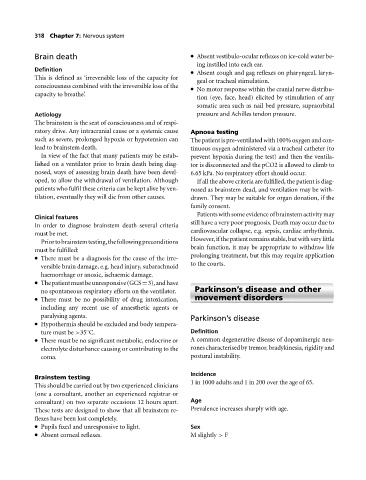Page 322 - Medicine and Surgery
P. 322
P1: FAW
BLUK007-07 BLUK007-Kendall May 25, 2005 18:18 Char Count= 0
318 Chapter 7: Nervous system
Brain death Absent vestibulo-ocular reflexes on ice-cold water be-
ing instilled into each ear.
Definition Absent cough and gag reflexes on pharyngeal, laryn-
This is defined as ‘irreversible loss of the capacity for
geal or tracheal stimulation.
consciousness combined with the irreversible loss of the No motor response within the cranial nerve distribu-
capacity to breathe’.
tion (eye, face, head) elicited by stimulation of any
somatic area such as nail bed pressure, supraorbital
Aetiology pressure and Achilles tendon pressure.
The brainstem is the seat of consciousness and of respi-
ratory drive. Any intracranial cause or a systemic cause Apnoea testing
such as severe, prolonged hypoxia or hypotension can The patient is pre-ventilated with 100% oxygen and con-
lead to brainstem death. tinuous oxygen administered via a tracheal catheter (to
In view of the fact that many patients may be estab- prevent hypoxia during the test) and then the ventila-
lished on a ventilator prior to brain death being diag- toris disconnected and the pCO2 is allowed to climb to
nosed, ways of assessing brain death have been devel- 6.65 kPa. No respiratory effort should occur.
oped, to allow the withdrawal of ventilation. Although If all the above criteria are fulfilled, the patient is diag-
patients who fulfil these criteria can be kept alive by ven- nosed as brainstem dead, and ventilation may be with-
tilation, eventually they will die from other causes. drawn. They may be suitable for organ donation, if the
family consent.
Patients with some evidence of brainstem activity may
Clinical features
still have a very poor prognosis. Death may occur due to
In order to diagnose brainstem death several criteria
cardiovascular collapse, e.g. sepsis, cardiac arrhythmia.
must be met.
However,ifthepatientremainsstable,butwithverylittle
Priortobrainstemtesting,thefollowingpreconditions
brain function, it may be appropriate to withdraw life
must be fulfilled:
prolonging treatment, but this may require application
There must be a diagnosis for the cause of the irre-
to the courts.
versible brain damage, e.g. head injury, subarachnoid
haemorrhage or anoxic, ischaemic damage.
Thepatientmustbeunresponsive(GCS=3),andhave
no spontaneous respiratory efforts on the ventilator. Parkinson’s disease and other
There must be no possibility of drug intoxication,
movement disorders
including any recent use of anaesthetic agents or
paralysing agents. Parkinson’s disease
Hypothermia should be excluded and body tempera-
◦
ture must be >35 C. Definition
There must be no significant metabolic, endocrine or
Acommon degenerative disease of dopaminergic neu-
electrolyte disturbance causing or contributing to the rones characterised by tremor, bradykinesia, rigidity and
coma. postural instability.
Incidence
Brainstem testing
1in 1000 adults and 1 in 200 over the age of 65.
This should be carried out by two experienced clinicians
(one a consultant, another an experienced registrar or
consultant) on two separate occasions 12 hours apart. Age
These tests are designed to show that all brainstem re- Prevalence increases sharply with age.
flexes have been lost completely.
Pupils fixed and unresponsive to light. Sex
Absent corneal reflexes. M slightly > F

